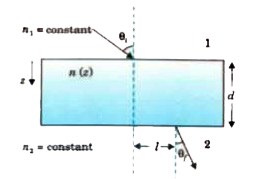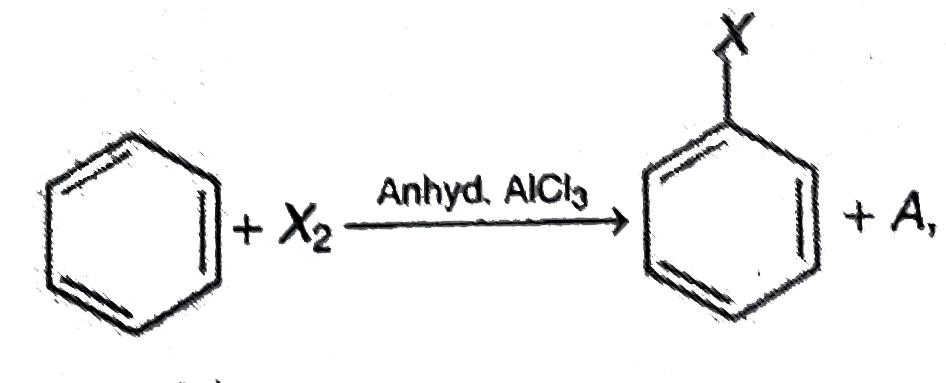 . Here Z is
. Here Z is




The correct Answer is:B
Topper's Solved these Questions
- ALCOHOLS, PHENOLS AND ETHERSBOOK - DISHA PUBLICATIONCHAPTER - ALCOHOLS, PHENOLS AND ETHERSEXERCISE - Exercise - 2 : Concept Applicator)
28 Videos
- ALCOHOLS, PHENOLS AND ETHERSBOOK - DISHA PUBLICATIONCHAPTER - ALCOHOLS, PHENOLS AND ETHERSEXERCISE - Exercise - 1 : Concept Builder (Topicwise)(TOPIC 2 : Preparation and Properties of Alcohols)
37 Videos
- ALDEHYDES, KETONES AND CARBOXYLIC ACIDSBOOK - DISHA PUBLICATIONCHAPTER - ALDEHYDES, KETONES AND CARBOXYLIC ACIDSEXERCISE - Exercise - 2 : Concept Applicator
27 Videos
Similar Questions
A transparent slab of thickness d has a refractive index n(z) that increases with z. Here z is the vertical distance inside the slab, measured from the top. The slab is placed between two media with uniform refractive indices n1 and n2(>n1), θ0, from medium 1 and emerges in medium 2 with refraction angle θtwith a lateral displacement l.
Which of the following statement(s) is (are) true?

View SolutionJ.C. Slater proposed an empirical constant that represents the cumulative extent to which the other electrons of an atom shield (or screen) any particular electron from the nuclear charge. Thus, slater's screening contant σ is as : Z∗=Z−σ
Here, Z is the atomic number of the atom, and hence is equal to the actual number of protons in the atom. the parameter Z∗ is the effective nuclear charge, which according to is smaller than Z, since the electron in question is screened (shielded) from Z by an amount σ. Conversely, an electron that is well shielded from the nuclear charge Z experiences a small effective nuclear charge Z∗.
The value of σ for any one electron in a given electron configuration (i.e., in the presence of the other electrons of the atom in question) is calculated using a set of empirical rules developed by slater. according to these rules, the value of σ for the electron in question is the cumulative total provided by the various other electrons of the atom.
Q. Which of the following statement is correct?
View Solution
Knowledge Check
A transparent slab of thickness d has a refractive index n(z) that increases with z. Here z is the vertical distance inside the slab, measured from the top. The slab is placed between two media with uniform refractive indices n1andn2(>n1), as shown in the figure. A ray of light is incident with angle θi, from medium 1 and emerges in medium 2 with refraction and θf, with a lateral displacement l.

Which of the following statement(s) is (are) true ?Al is independent of n2Bn1sinθ1=n2sinθfCl is independent of n(z)Dn1sinθ1=(n2−n1)sinθfA transparent slab of thickness d has a refractive index n(z) that increases with z. Here z is the vertical distance inside the slab, measured from the top. The slab is placed between two media with uniform refractive indices n1 and n2(>n1), θi, from medium 1 and emerges in medium 2 with refraction angle θfwith a lateral displacement l.
Which of the following statement(s) is (are) true?
 An1sinθi=n2sinθfBn1sinθi=(n2−n1)sinθfCl is independent of n2Dl is dependent of n(z)
An1sinθi=n2sinθfBn1sinθi=(n2−n1)sinθfCl is independent of n2Dl is dependent of n(z)J.C. Slater proposed an empirical constant that represents the cumulative extent to which the other electrons of an atom shield (or screen) any particular electron from the nuclear charge. Thus, slater's screening contant σ is as : Z∗=Z−σ
Here, Z is the atomic number of the atom, and hence is equal to the actual number of protons in the atom. the parameter Z∗ is the effective nuclear charge, which according to is smaller than Z, since the electron in question is screened (shielded) from Z by an amount σ. Conversely, an electron that is well shielded from the nuclear charge Z experiences a small effective nuclear charge Z∗.
The value of σ for any one electron in a given electron configuration (i.e., in the presence of the other electrons of the atom in question) is calculated using a set of empirical rules developed by slater. according to these rules, the value of σ for the electron in question is the cumulative total provided by the various other electrons of the atom.
Q. Which of the following statement is correct?AA 4s-orbital is filled earlier than a 3d-orbital because, Z∗ for 3d>Z∗ for 4s.BA 4s-orbital is filled earlier than a 3d-orbital because, Z∗ for 4s>Z∗ for 3dCThe effective nuclear charge for 3d-and 4s-orbitals are same, but energy of 3d-orbital becomes higher.DThe effective nuclear charge for 3d and 4s-orbitals are same but, energy of 4s-orbital becomes higher.




